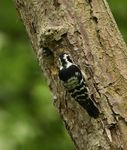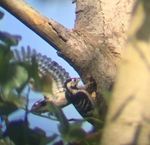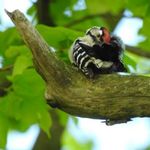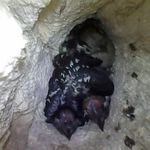Lesser spotted woodpecker nest recording in 2018
←
→
Page content transcription
If your browser does not render page correctly, please read the page content below
Lesser spotted woodpecker nest recording in 2018 Ken Smith & Linda Smith October 2018 Thank you to everyone who has contributed to the Lesser Spotted Woodpecker studies in 2018. The project and our website have generated a great deal of interest again this year and we have been kept very busy responding to e-mails and following up reports of nests. No complaints – this is what we have set out to do! Lesser Spots remain a very challenging species. We received reports of territorial birds or pairs from 85 sites this year but despite big efforts by ourselves and some other especially dedicated observers, only ten nests were found and monitored in Cheshire, Devon, Herefordshire, Norfolk, Nottinghamshire, West Glamorgan and the New Forest (4 nests). In addition, at two other sites, one in the New Forest and one in Female in an Essex garden on 8 April, photo: Tony Wells East Sussex, young recently out of the nest and still being fed by the adults were found although the nests were never located. We now have four nest inspection camera systems available which we have been able to loan to local observers (for details see our website). Using these cameras, we are able to record clutch size for those nests found early enough in the nesting cycle and the numbers of chicks fledged from most nests – information vital to help understand the reasons for the decline of the Lesser Spotted Woodpeckers. We use light weight telescopic poles (normally used by window cleaners) to get the cameras up to the nest holes. The nest inspection only takes a few minutes and our experience to date with nearly 100 nests shows it is safe for the birds and the observers. Rather inconveniently, Lesser Spots, sometimes nest so high in the tree that they are beyond the reach of even these poles. Even if the contents of these nests are not known for sure we can still get valuable information on the timing and success of the nests from repeated observations of the behaviour of the adults as they incubate the Ken and Linda inspecting a low nest in the New Forest and Malcolm Burgess at a more eggs and then feed the challenging one in Devon. Photos by Martin Bennett and David Price young. Details of the nests found in 2018 and their outcomes are given in Table 1.
Table 1. Summary of the nests with eggs or young monitored in 2018.
Site Nest Nest Found Number Number Estimated Habitat Nest
tree1 site2 during of eggs of young fledge day camera
laid fledged checks
Norfolk Poplar D Excavation 5 4 May 31 Woodland Apr 30,
D edge May 20,
27 & 31
Cheshire Alder D Excavation nc nc June 8 Wet None
D woodland
Herefordshire Willow D Feeding nc 3 June 16 Orchard June 1,
A young 11 & 16
Devon Oak D Incubation 4 4 June 9 Woodland May 17
D & 29,
June 10
Nottinghamshire Willow D Feeding nc 2+ June 10 Parkland/ None
A young woodland
edge
West Alder D Feeding nc 1+ June 12 Woodland None
Glamorgan D young
New Forest (1) Holly D Feeding nc 3 June 7 Woodland June 1
D young &6
New Forest (2) Beech D Feeding nc 2 June 7 Woodland No, nest
A young too high
New Forest (3) Alder D Feeding nc 2 June 14 Woodland June 9
D young & 12
New Forest (4) Oak D Feeding nc 2 June 21 Woodland June 17
D young
1. A=living tree, D=dead tree.
2. The nest sites were all in dead substrate D. Either a dead tree or a dead branch or limb on a living
tree.
Photographs taken with the nest inspection camera (Ken and Linda Smith)
Norfolk nest on 30 April New Forest (1) chicks, 2m & 1f New Forest (3) chicks, 1m & 1f
The overall success was good with no failures recorded in the nests we monitored and an average of 2.9
young fledged per nest. The main feature of the 2018 season was its lateness. Most young did not fledge
until mid-June which is about 10-14 days later than usual. It seems that the cold spell in early spring delayed
the start of nesting for most pairs. Early indications from BTO nest recorders are that late nesting has been
the norm for many species in 2018.
For our Lesser Spots, the exception to the late timing was the pair in Norfolk which successfully fledged
four young from a nest close to their 2017 site on May 31 in line with the timing of nests found in previous
years. These birds were watched regularly through the winter and into spring by Mat Shore and Ricky
Cleverley who collected valuable information on interactions with other Lesser Spots when establishing
territory (there seemed to be extra young birds trying to get established), visit rates to the nest and fooditems brought to the young. It seems these were a well- established pair and earlier studies in Sweden (Wiktander et al. 2001) have demonstrated that established pairs tend to nest early and fledge more young than pairs involving first time breeders. As a little experiment, Mat and Ricky provided supplementary food near this pair’s 2017 nest site through the winter and into spring which may also have been a factor in allowing the birds to lay early and sustain incubation through the cold snap in spring. In Herefordshire, Nick Gates and Ben MacDonald found their Lesser Spots excavating very low down in a dead Apple; perfect for easy nest inspections they thought. Unfortunately, a limb from a nearby oak tree fell and flattened the Apple so the birds had to start excavating all over again with a new cavity about 50m away. Such chance events can delay nesting, but it is often the case that birds The Norfolk pair on 12 May, photo: Ricky Cleverley make false starts to excavation choosing unsuitable sites before making their final selection. This could well be a factor for inexperienced birds doing less well than experienced ones. In East Sussex, Graeme Lyons was amazed to hear persistent Lesser Spot calls whilst conducting a botanical and entomological survey in some valley meadows on June 3. By coincidence we were nearby checking out another Lesser Spot site so were able to search the area with Graeme that afternoon. After some careful watching and searching we realized there was a family party in the hedgerow trees and small copses the young were moving about and calling to be fed. We have no idea where the birds had nested although there were some dead elms and a small poplar plantation on the river which looked likely places. This was a new site but was only about 5km from a site with drumming birds in 2017. In the New Forest, Rob Clements observed an adult Lesser Spot making repeated flights across a clearing with food in its beak on June 13 and, despite careful searching at the time, he was unable to find the nest. When we did a tree by Nottinghamshire female feeding female chick on 7 tree search through the area on June 15 there were no signs June 2018, photo: Amanda Sinclair of the birds or a used nest. In Lincoln, Andy Sims had a drumming male around the nest tree used in 2015 and 2016. This bird (pictured right) was drumming at three sites within about 1km of each other but there was no evidence of a nest or a female. Although we can’t be sure, because the birds have never been marked, in 2017 what was probably the same bird drummed throughout the season without attracting a female. It is amazing that it still seems to be around but may be symptomatic of what can happen when a species gets to very low numbers. This is the fourth year of our initiative and we have now collected data from a total of 43 nests which is starting to become a feasible sample for formal analysis. The original motivation for the work was to check whether poor breeding success for Lesser Spots was widespread in Britain. In none of the four years since 2015 can the nesting success be described Lincoln lone male, photo: Andy Sims
The Herefordshire male gliding through the canopy like a miniature Concord, 13 June, photo sequence by Nick Gates as outstanding but in three out of four it has been reasonable. Only in 2016 was it so low (1.2 young fledged per nest) to be comparable with the earlier RSPB studies. In the other years it has ranged between 2.2 and 3.7 young fledged per nest. This is still lower than other European studies (Smith & Charman 2012) but not as disastrously so as we thought. We appreciate that researchers always say that more research is needed, but we do desperately need more nests to be monitored over the next few years to confirm these findings. We found no instances this year of nest failures as a result of interactions with Great Spotted Woodpecker, but we did get one report of an excavating Lesser Spot being displaced by a Great Spot. Such displacement is not often recorded but we suspect it is now quite a common occurrence. The interaction between the two woodpeckers is not simple. It seems that Great Spots are more likely to predate the young of other species when they are having difficulty finding enough food for their own young. At the Devon site this year there was even an active Great Spot nest within 20m of the Lesser Spot with both fledging young successfully – presumably there was enough invertebrate food around for all the young. Some observers are reluctant to report Lesser Spot nests to us for fear of the sites becoming subject to excessive disturbance. We are quite clear that we respect the wishes of observers when it comes to site confidentiality and we don’t reveal site details in this report or any other. However, we have noted frequently over the last few years that Lesser Spots often place their nests in very public and busy places – a north London park and a heavily used picnic site on a cycle path come to mind – so we do wonder how sensitive to disturbance they really are. Certainly, when they are feeding young they largely ignore human observers unless the nest is very low down or the observers are very close. We do suspect that they are more sensitive when deciding where to nest and when excavating their cavity and, unfortunately, this is just the time when they are likely to come under most pressure from birdwatchers and Checking out a very public Lesser Spot nest site
photographers. As we have shown any
delay in nesting, say if the birds decide
the move to a less disturbed site, is
likely to result in lower breeding
success and poorer prospects for the
local population. We urge all observers,
particularly at this time, to exercise
common sense and give the birds the
space and time to get on with their
nesting attempt.
We are planning to continue the nest
recording initiative in 2019.
In the New Forest, clearly an important
stronghold for Lesser Spots, Rob
Clements will be continuing his surveys
next year. Interestingly we have
recently been contacted by Prof Ola
Olsson to say that he has funding to Lesser Spot nest 3 in the New Forest, in a typical location - a dead
repeat the pioneering work that he and alder in mixed woodland alongside a open area and next to a stream
Ulf Wiktander did on Lesser Spots in
Sweden in the 1990s. It will be interesting to see how their populations and breeding biology have changed
over the last two decades.
Lesser Spotted Woodpeckers are now in such low numbers that they are only monitored nationally by
records coming from bird watchers submitted to the Rare Breeding Birds Panel (RBBP) through the county
recorder network. We have already helped RBBP with guidance on recording breeding Lesser Spots and
have been talking to them about how best to improve the recording. One idea is to compile a list of regular
sites and record the occupancy each year. With this in mind, we have started work on compiling such a list.
With help from RBBP and county recorders we plan to work on this over the winter.
References
Smith K W & Charman E C (2012) The ecology and conservation of the Lesser Spotted Woodpecker.
British Birds 105, 294-307.
Wiktander U, Olsson O & Nilsson S G (2001). Annual and seasonal reproductive trends in the Lesser
Spotted Woodpecker Dendrocopos minor. Ibis 143, 72-82.
Acknowledgements
We thank everyone for their efforts in 2018.
Nests were found and reported to us by Mat Shore, Ricky Cleverley, Rob Clements, Nick Gates, Ben
MacDonald, David Price, Malcolm Burgess, Allan Rustell, Amanda Sinclair, Rob Hoare, Richard Dann,
Mark Swann and Simon Currie.
We particularly thank Rob Clements, Mark Mallalieu, Ben MacDonald and Paul Cox who searched large
areas without always finding the nests.
In addition to all this activity, we received reports of breeding birds from Martin Allison, Kevin Armstrong,
Mark Askew, Nick Brown, Phil Burnham, Andy Butler, Robert Callf, David Carter, Stephen Chapman, Liz
Charman, Alan Coles, Martin Daniel, Lawrence Dare, Ralph Darvill, Tara Dempsey, Graham Dennis, Tony
Ducket, Alan Eardley, Lee Evans, Les Evans-Hill, Howard Fearn, James Fisher, Fiona Freshney, Martin
Garwood, Chris Green, Penny Green, Indy Kiemel Greene, Chris Hill, Gerry Hinchon, Justin Lane, Simon
Linington, Graeme Lyons, Joe Margetts, Juliet & Chris Moore, Otley Birding, Marian Pateman, Mike
Pollard, Geoff Ralph, Julie & Malcolm Redford, Allz Redman, Kev Roy, Chris Sharp, John Simons, Andy
Sims, Pete Sofley, Mark Speck, Ed Stubbs, Lewis Thomson, Nick Uddy, Tony Vials, Rik Vonk, Tom
Wallis, Tony Wells, Nigel Wilde, Peter Williams.
Thanks to all those who sent us photos and Martin Bennett, Ricky Cleverley, Nick Gates, David Price, Andy
Simms, Amanda Sinclair and Tony Wells for the photographs used in this report.
Keep in touch through the Woodpecker Network www.woodpecker-network.org.uk
Twitter: @lesserspotnet and email: ken.smith.lsw@gmail.comYou can also read



























































